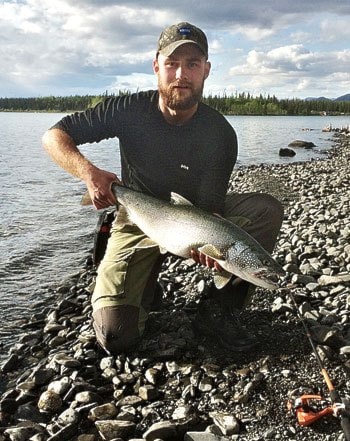When Whitehorse’s Barbara Robinson looked down at the man beside her on her Air North flight, he was wearing socks but no shoes. So she asked why.
The story behind 70-year-old Frank Glass’s wet leather boots, now safely tucked in the overhead cabin, would take the remainder of the flight.
Just a few days earlier, Glass had gazed at his friend, Yukoner Don Francis, comatose and clinging to the stern of the canoe in the middle of icy, glacier-fed Kathleen Lake, doubtful they would make it to shore.
Francis and Glass are no strangers to the outdoors. The two friends and colleagues have conducted geological fieldwork in the bush for their entire careers. But no amount of experience and safety precautions can save a person from a dramatic shift in winds in the deep valleys and frigid waters at Kluane National Park and Reserve.
The two scientists had been attending the Geological Association of Canada’s annual three-day conference in Whitehorse. Having met at the same event the previous year in Montreal, they quickly found they shared a love for the bush and a love for dogs. So Francis invited Quebec City resident Glass to come visit his remote cabin near Kluane park. Eager to spend their free day in the bush, they headed out with Kody, Francis’s eight-month-old Portuguese water dog, to admire the geology first-hand at one of Yukon’s renowned natural gems.
It was breezy with occasional clouds but the sun was out as they set their canoe in the water around 1 p.m., Glass said.
But after silently taking in the scenery of their small beach destination across the lake, the waves swelled. Since they had launched from the public shore, the winds had shifted dramatically and they found themselves with the canoe parallel to the oncoming and increasingly strong waves.
It was about halfway along their journey back towards the public beach that the canoe first capsized.
“The dog was inside the upside down canoe and I had to retrieve him,” Glass said. While they tried to save the three paddles and a small floating device, the dog - claws scratching - kept swimming away as the wind relentlessly turned and flipped the canoe.
“At the moment you have no other thoughts than trying to save that dog. He had on a life vest, so it was quite easy to pluck him up and plop him into the canoe. But he was frantic and confused, and kept jumping out and swimming in all directions.”
Though the two men also had life jackets, they were freezing and still 20 to 30 metres from shore. “I was at my limit,” Glass said. “I had gone past it. I was just waiting within five or ten seconds left - I knew by the way I was breathing,” he said. “My legs weren’t moving anymore and breathing more wasn’t going to help.”
Unable to scissor-kick the canoe the last third of the way to shore and his friend equally paralyzed, Glass thought it was over.
It was at just this moment that Jeppe Aaquist from Denmark, who had been anxiously watching the scene unfold from the beach, left his two fishing companions.
The Danish military sergeant, who is “used to cold water,” whipped his clothes off and jumped into the freezing, white-capped lake to save the floundering three, swimming them all to shore.
On the beach, Aaquist ripped off Glass’ clothes and replaced them with his own dry shirt and jacket, rubbing his arms vigorously.
“Frank was hit the worst,” Aaquist said. “He was in shock, he could barely speak.”
The group pulled the rescued crew to the beach-side cabin, covered them in blankets and managed to find a park ranger driving by who was able to radio the Haines Junction ambulance, which arrived shortly afterwards.
“People had no obligation to save us, it would have been dangerous for anyone to do this. It is most unusual to go into cold water with only a swim suit,” Glass said.
“Had it not been for that (man) I wouldn’t be here. I work in the bush a lot around the world and have quite often had bad situations. Normally I am in the situation to jump in and save someone,” he added. Francis has canoed around Arctic islands, while Glass has paddled the deep, rough waters of the West Coast Inside Passage, but they had never capsized like this. “At a certain moment in very cold water the switches simply turn off,” Glass said.
“As I was going out in the stretcher, I reached over and shook his hand and thanked him,” Glass said. That was the last he saw of Aaquist, though they are now in contact through email. Glass hopes they can invite him to return again to visit Francis’s Yukon cabin. “The Governor General should give the person who saved us a prize,” Glass said.
After a few hours of monitoring at the Haines hospital, Glass was released.
As for Kody, the pup: “When I got into the truck after the hospital - still in my gown - he licked my arm,” Glass said. “Usually he sits in our seats and plays when we try and get in the car, but when Don and I got into our seats, for the first time he licked and kissed our arms.”
As for the hero himself, this isn’t the first time he’s made a valiant rescue. “Yeah, I have saved one before,” Aaquist said. “A kid that had his wrist cut open and bleeding out, in Denmark, after he fell through a window.”
Contact Lauren Kaljur at
lauren.kaljur@yukon-news.com
